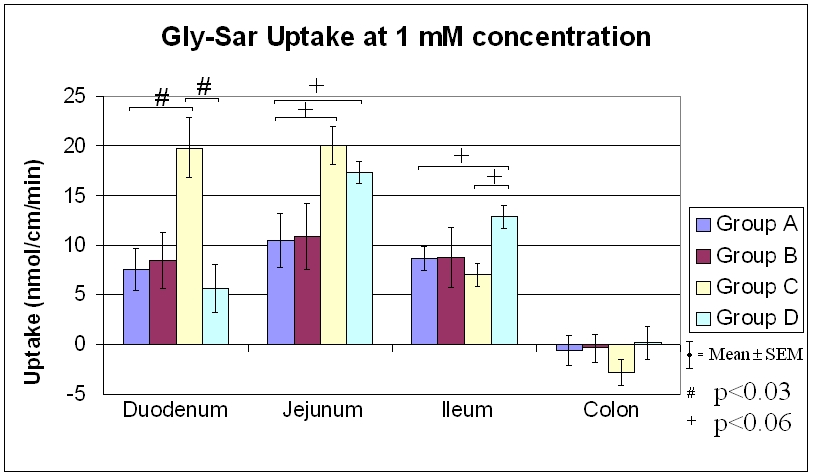Intestinal Adaptation of Oligopeptide Absorption Via Pept1 After Massive (70%) Mid Small Bowel Resection
Srivats Madhavan*, Jeffrey S. Scow, Munenori Nagao, Ye Zheng, Judith a. Duenes, Michael G. Sarr
Dept. of Surgery and Gastroenterology Research Unit, Mayo Clinic, Rochester, MN
Dietary proteins are absorbed primarily as di- and tri- peptides via H+/peptide cotransporter (PepT1), a high-capacity, low-affinity apical membrane transporter. AIM: To characterize mechanism(s) of intestinal adaptation of peptide absorption after massive (70%) mid small bowel resection. METHODS: Male Lewis rats (200-250g) were assigned randomly to 4 groups; A) Non-operated control (n=8), B) Sham-operated (transection and primary anastomosis without resection) (n=4), C and D) 70% mid small bowel resection with primary anastomosis of remnant jejunum and ileum studied at 1wk (Group C) (n=5) and 4wk (Group D) (n=5) postoperatively resp. Duodenum, proximal jejunum, distal ileum and colon were harvested at 0, 1, 1, and 4wk in Groups A, B, C, and D resp. Uptake of the 14C-labeled non-hydrolizable dipeptide glycyl-sarcosine (gly-sar), was measured at a concentration of 1mM in all bowel segments by the everted sleeve technique. Mucosa was harvested to measure gene expression of PepT1 (mRNA by real time RT-PCR; protein by Western blot) and normalized to values for housekeeper genes (GAPDH and β-actin). Results are mean±SEM. RESULTS: Rats that had 70% small bowel resection lost 19±4g weight at 1wk (Group C) compared to 2±4g in sham operated (Group B) (p≤0.02), but gained 59±5g by 4wk (Group D). Gly-sar uptake (nmol/cm/min) did not differ between Groups A and B in any of the 4 regions evaluated (data not shown). Gly-sar uptake tended to be greatest in jejunum for all groups except Group C (Figure). Uptake in duodenum of Group C was greater than control Group A (p<0.003). This augmentation in duodenal uptake did not persist at 4wk in Group D. Gly-sar uptake in ileum was increased in Group D compared to Groups A and C (p<0.06 each). Colonic uptake of gly-sar was negligible in all groups. PepT1 gene expression studies (mRNA and protein) are pending. CONCLUSION: Early adaptation in peptide absorption to massive resection occurs in duodenum. Distal ileum requires longer to adapt. Early adaptive changes in duodenum are transient as distal ileum adapts.
Back to Program




